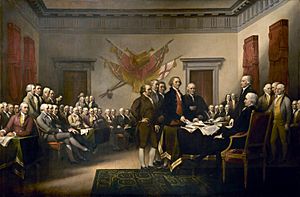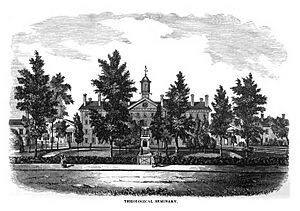Scottish common sense realism facts for kids
Scottish common sense realism is a way of thinking that started in Scotland during the 1700s. It was developed by philosophers like Thomas Reid, Adam Ferguson, James Beattie, and Dugald Stewart.
The main idea is that people are born with a natural ability to understand basic truths. These truths are often called "common sense." This way of thinking says that common sense is the most important starting point for understanding the world.
This philosophy was well-known for disagreeing with the ideas of David Hume. Scottish common sense realism also had a big impact on thinkers like Thomas Jefferson and on American politics in the late 1700s.
Contents
The History of Common Sense Thinking
The Scottish School of Common Sense was a philosophy about how we gain knowledge. It became very popular in Scotland in the late 1700s and early 1800s. Its ideas came from responses to the writings of philosophers like John Locke, George Berkeley, and David Hume.
Important members included Dugald Stewart, Thomas Reid, and William Hamilton. This Scottish way of thinking helped to argue against scepticism, which is the idea that we can't really know anything for sure. It also fit well with the teachings of famous scientists like Isaac Newton and Francis Bacon.
One main goal of this school was to protect "common sense" from confusing ideas and doubt. They believed that common-sense beliefs guide everyone's lives and thoughts. Even people who say they don't believe in common sense still use it every day. They also argued that common sense is key to learning anything new.
What Scottish Common Sense Realism Teaches
Thomas Reid started the Scottish School of Common Sense. He disagreed with René Descartes's idea that our minds only deal with "ideas" and not directly with the real world. Other thinkers like John Locke and David Hume also explored how we learn from our senses. However, their ideas sometimes led to skepticism, which Reid and others found hard to believe.
David Hume's skeptical arguments became the main challenge for Reid's philosophy. Reid worked on his book, An Inquiry into the Human Mind on the Principles of Common Sense, for 40 years. He often asked for advice from other thinkers in the Scottish Enlightenment, including Hume himself.
Reid explained the main idea of Common Sense Realism like this: "If there are certain principles... which our nature leads us to believe, and which we must accept in daily life, without being able to explain why—these are what we call the principles of common sense. And anything that clearly goes against them is what we call absurd."
Scottish Common Sense Realism is based on the ideas of Aristotle. It supports a scientific way of thinking where we naturally trust our senses. The principles of common sense are vital for us to gain knowledge about both the physical world and deeper ideas. However, just observing things isn't enough for all knowledge. We can also find truth by thinking deeply.
Reid also said: "I can imagine a real object that exists, like St. Paul's Cathedral in London. I have an idea of it; I imagine it. The object I'm thinking about is 400 miles away. I have no reason to think it affects me or that I affect it."
Our "faculties," or mental abilities, help us perceive and understand things. These mental powers support many different thought processes. For example, judging that a door is in front of you, imagining a door, or thinking that all doors have handles are all acts of understanding. Our faculties can sometimes make mistakes. However, we trust them in our daily lives because they always guide us. Reid's entire philosophy relies on these faculties being mostly reliable. Our senses are part of these faculties. They help us understand qualities (like how a smell suggests an object) and form our beliefs. Freedom is another natural belief that comes from our faculties. These faculties are the "foundation of true philosophy, science, and practical life." Without them, we would fall into doubt and despair.
The school taught that everyone has everyday experiences that give them certain knowledge. This includes knowing that:
- You exist as a person.
- Real objects exist that you can see and feel.
- There are certain "first principles" that help build good morals and religious beliefs.
These ideas formed the basis for Reid's important theory of how we perceive things.
In practice, Scottish philosophers used scientific explanations for historical events. They also supported an open-minded approach to education, free from strong religious or national biases.
How We Perceive Things
Thomas Reid and Dugald Stewart both had ideas about perception that came from Scottish Common Sense Realism. Nicholas Wolterstorff from Yale University explains Reid's philosophy with four main points:
- When we perceive things, we are seeing real objects outside of our minds. These objects exist in space.
- To perceive an object, that object must cause us to understand it. It also makes us immediately believe it's there, without having to think about it.
- Humans are made in a way that external objects cause us to understand and believe in them. This happens because the object creates a feeling in us, which then leads to the understanding and belief.
- This feeling can cause the understanding and belief even if we aren't fully paying attention to the feeling itself.
Dugald Stewart's ideas about perception were greatly influenced by Reid. Stewart called Reid's philosophy "fundamental laws of belief." However, Stewart had a slightly more balanced view of realism. His theory of perception focused more on how useful our senses are.
The Impact of Common Sense Realism
Common Sense Realism was not only popular in Scotland in the 1800s. It also had a big impact in France, the United States, and other countries. Victor Cousin was a key supporter in France. Reid's ideas were the main philosophy taught in colleges and universities in the early 1700s. They provided a strong base for the Age of Enlightenment.
Influence on the American Declaration of Independence

Common Sense Realism quickly became popular among thinkers in America in the 1700s. Reid's philosophy was very important during the American Revolution. It helped to provide stable ideas during that time.
Some even called Benjamin Rush the "father of modern psychiatry." He studied at the University of Edinburgh and learned strong realist ideas there. These ideas influenced much of his scientific and political work, including his moral opposition to slavery.
You can easily see the influence of Scottish Common Sense realism in the ideas of both Thomas Jefferson and John Adams. Adams even compared Dugald Stewart's work to that of famous thinkers like Aristotle and René Descartes.
John Witherspoon, a Scotsman who signed the Declaration of Independence, was the president of Princeton University. Many students he taught became important figures, including 12 state governors, 55 delegates to the Constitutional Convention, and future president James Madison. His education at the University of Edinburgh made him a strong supporter of the Scottish Enlightenment and Realism.
Later, James McCosh continued the influence of Scottish Realism at Princeton when he became president in 1868. This helped Princeton become a major center for this way of thinking. Noah Porter also taught Common Sense realism to many students at Yale for generations.
Impact on Christian Beliefs
Scottish Realism greatly influenced conservative religious thought. It was strongest at Princeton Seminary until the Seminary changed its direction after 1929. The theologians at Princeton built their system of beliefs on "common-sense" realism, the Bible, and their religious confessions.
James McCosh was brought from Queen's College, Belfast, to be the Chair of Moral Philosophy and President at Princeton College. This was because of his book, "The Method of Divine Government." This Christian philosophy came before Charles Darwin's "The Origin of Species" (1859). Several Princeton Theologians followed McCosh in accepting the idea of theistic evolution, which combines evolution with belief in God.
McCosh's goal was to make Princeton a leading Christian university in North America. He also wanted it to be an important seminary for the Presbyterian Church. The college and seminary faculty included thinkers who believed in evolution and those who did not. Much of the evangelical theology today is based on Princeton theology. This means it still reflects Common Sense Realism.
New Testament scholar Grant Osborne says that Scottish Common Sense Realism influenced how people understood the Bible. He noted that a simple, surface-level understanding of Scripture became popular. This also led to many individual interpretations of the Bible.
See also
- Adam Smith
- Direct realism
- Francis Hutcheson (philosopher)
- Scottish common sense realism § Notes
- James Frederick Ferrier
- Naive realism
- Scottish philosophy
- Thomas Brown (philosopher)




